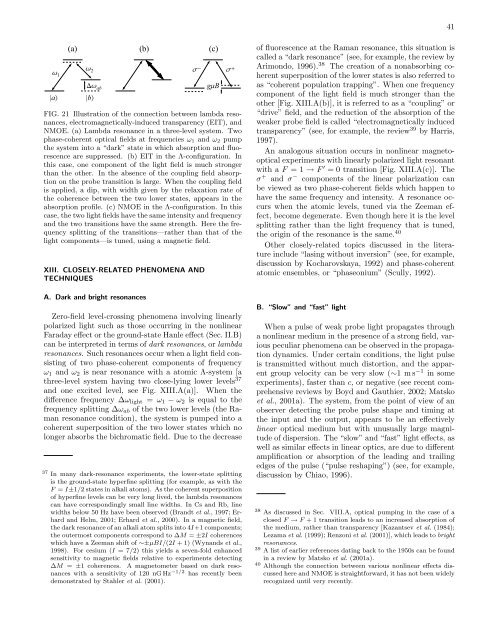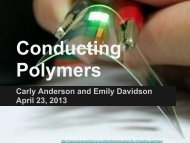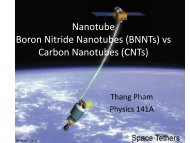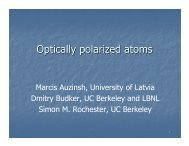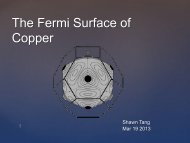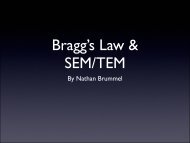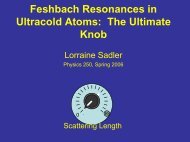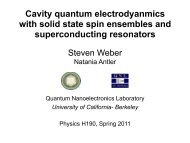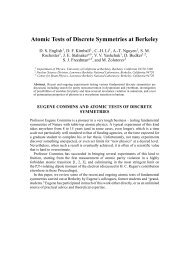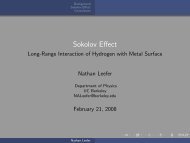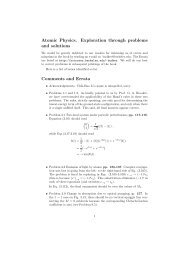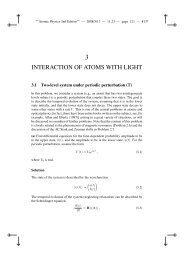Resonant nonlinear magneto-optical effects in atomsâ - The Budker ...
Resonant nonlinear magneto-optical effects in atomsâ - The Budker ...
Resonant nonlinear magneto-optical effects in atomsâ - The Budker ...
You also want an ePaper? Increase the reach of your titles
YUMPU automatically turns print PDFs into web optimized ePapers that Google loves.
41<br />
Ω <br />
|a<br />
(a) (b) (c)<br />
Ω <br />
Ω ab<br />
|b<br />
Σ <br />
gΜB<br />
FIG. 21 Illustration of the connection between lambda resonances,<br />
electromagnetically-<strong>in</strong>duced transparency (EIT), and<br />
NMOE. (a) Lambda resonance <strong>in</strong> a three-level system. Two<br />
phase-coherent <strong>optical</strong> fields at frequencies ω 1 and ω 2 pump<br />
the system <strong>in</strong>to a “dark” state <strong>in</strong> which absorption and fluorescence<br />
are suppressed. (b) EIT <strong>in</strong> the Λ-configuration. In<br />
this case, one component of the light field is much stronger<br />
than the other. In the absence of the coupl<strong>in</strong>g field absorption<br />
on the probe transition is large. When the coupl<strong>in</strong>g field<br />
is applied, a dip, with width given by the relaxation rate of<br />
the coherence between the two lower states, appears <strong>in</strong> the<br />
absorption profile. (c) NMOE <strong>in</strong> the Λ-configuration. In this<br />
case, the two light fields have the same <strong>in</strong>tensity and frequency<br />
and the two transitions have the same strength. Here the frequency<br />
splitt<strong>in</strong>g of the transitions—rather than that of the<br />
light components—is tuned, us<strong>in</strong>g a magnetic field.<br />
XIII. CLOSELY-RELATED PHENOMENA AND<br />
TECHNIQUES<br />
A. Dark and bright resonances<br />
Zero-field level-cross<strong>in</strong>g phenomena <strong>in</strong>volv<strong>in</strong>g l<strong>in</strong>early<br />
polarized light such as those occurr<strong>in</strong>g <strong>in</strong> the <strong>nonl<strong>in</strong>ear</strong><br />
Faraday effect or the ground-state Hanle effect (Sec. II.B)<br />
can be <strong>in</strong>terpreted <strong>in</strong> terms of dark resonances, or lambda<br />
resonances. Such resonances occur when a light field consist<strong>in</strong>g<br />
of two phase-coherent components of frequency<br />
ω 1 and ω 2 is near resonance with a atomic Λ-system [a<br />
three-level system hav<strong>in</strong>g two close-ly<strong>in</strong>g lower levels 37<br />
and one excited level, see Fig. XIII.A(a)]. When the<br />
difference frequency ∆ω light = ω 1 − ω 2 is equal to the<br />
frequency splitt<strong>in</strong>g ∆ω ab of the two lower levels (the Raman<br />
resonance condition), the system is pumped <strong>in</strong>to a<br />
coherent superposition of the two lower states which no<br />
longer absorbs the bichromatic field. Due to the decrease<br />
37 In many dark-resonance experiments, the lower-state splitt<strong>in</strong>g<br />
is the ground-state hyperf<strong>in</strong>e splitt<strong>in</strong>g (for example, as with the<br />
F = I±1/2 states <strong>in</strong> alkali atoms). As the coherent superposition<br />
of hyperf<strong>in</strong>e levels can be very long lived, the lambda resonances<br />
can have correspond<strong>in</strong>gly small l<strong>in</strong>e widths. In Cs and Rb, l<strong>in</strong>e<br />
widths below 50 Hz have been observed (Brandt et al., 1997; Erhard<br />
and Helm, 2001; Erhard et al., 2000). In a magnetic field,<br />
the dark resonance of an alkali atom splits <strong>in</strong>to 4I+1 components;<br />
the outermost components correspond to ∆M = ±2I coherences<br />
which have a Zeeman shift of ∼±µBI/(2I + 1) (Wynands et al.,<br />
1998). For cesium (I = 7/2) this yields a seven-fold enhanced<br />
sensitivity to magnetic fields relative to experiments detect<strong>in</strong>g<br />
∆M = ±1 coherences. A <strong>magneto</strong>meter based on dark resonances<br />
with a sensitivity of 120 nG Hz −1/2 has recently been<br />
demonstrated by Stahler et al. (2001).<br />
Σ <br />
of fluorescence at the Raman resonance, this situation is<br />
called a “dark resonance” (see, for example, the review by<br />
Arimondo, 1996). 38 <strong>The</strong> creation of a nonabsorb<strong>in</strong>g coherent<br />
superposition of the lower states is also referred to<br />
as “coherent population trapp<strong>in</strong>g”. When one frequency<br />
component of the light field is much stronger than the<br />
other [Fig. XIII.A(b)], it is referred to as a “coupl<strong>in</strong>g” or<br />
“drive” field, and the reduction of the absorption of the<br />
weaker probe field is called “electromagnetically <strong>in</strong>duced<br />
transparency” (see, for example, the review 39 by Harris,<br />
1997).<br />
An analogous situation occurs <strong>in</strong> <strong>nonl<strong>in</strong>ear</strong> <strong>magneto</strong><strong>optical</strong><br />
experiments with l<strong>in</strong>early polarized light resonant<br />
with a F = 1 → F ′ = 0 transition [Fig. XIII.A(c)]. <strong>The</strong><br />
σ + and σ − components of the l<strong>in</strong>ear polarization can<br />
be viewed as two phase-coherent fields which happen to<br />
have the same frequency and <strong>in</strong>tensity. A resonance occurs<br />
when the atomic levels, tuned via the Zeeman effect,<br />
become degenerate. Even though here it is the level<br />
splitt<strong>in</strong>g rather than the light frequency that is tuned,<br />
the orig<strong>in</strong> of the resonance is the same. 40<br />
Other closely-related topics discussed <strong>in</strong> the literature<br />
<strong>in</strong>clude “las<strong>in</strong>g without <strong>in</strong>version” (see, for example,<br />
discussion by Kocharovskaya, 1992) and phase-coherent<br />
atomic ensembles, or “phaseonium” (Scully, 1992).<br />
B. “Slow” and “fast” light<br />
When a pulse of weak probe light propagates through<br />
a <strong>nonl<strong>in</strong>ear</strong> medium <strong>in</strong> the presence of a strong field, various<br />
peculiar phenomena can be observed <strong>in</strong> the propagation<br />
dynamics. Under certa<strong>in</strong> conditions, the light pulse<br />
is transmitted without much distortion, and the apparent<br />
group velocity can be very slow (∼1 m s −1 <strong>in</strong> some<br />
experiments), faster than c, or negative (see recent comprehensive<br />
reviews by Boyd and Gauthier, 2002; Matsko<br />
et al., 2001a). <strong>The</strong> system, from the po<strong>in</strong>t of view of an<br />
observer detect<strong>in</strong>g the probe pulse shape and tim<strong>in</strong>g at<br />
the <strong>in</strong>put and the output, appears to be an effectively<br />
l<strong>in</strong>ear <strong>optical</strong> medium but with unusually large magnitude<br />
of dispersion. <strong>The</strong> “slow” and “fast” light <strong>effects</strong>, as<br />
well as similar <strong>effects</strong> <strong>in</strong> l<strong>in</strong>ear optics, are due to different<br />
amplification or absorption of the lead<strong>in</strong>g and trail<strong>in</strong>g<br />
edges of the pulse (“pulse reshap<strong>in</strong>g”) (see, for example,<br />
discussion by Chiao, 1996).<br />
38 As discussed <strong>in</strong> Sec. VIII.A, <strong>optical</strong> pump<strong>in</strong>g <strong>in</strong> the case of a<br />
closed F → F + 1 transition leads to an <strong>in</strong>creased absorption of<br />
the medium, rather than transparency [Kazantsev et al. (1984);<br />
Lezama et al. (1999); Renzoni et al. (2001)], which leads to bright<br />
resonances.<br />
39 A list of earlier references dat<strong>in</strong>g back to the 1950s can be found<br />
<strong>in</strong> a review by Matsko et al. (2001a).<br />
40 Although the connection between various <strong>nonl<strong>in</strong>ear</strong> <strong>effects</strong> discussed<br />
here and NMOE is straightforward, it has not been widely<br />
recognized until very recently.


